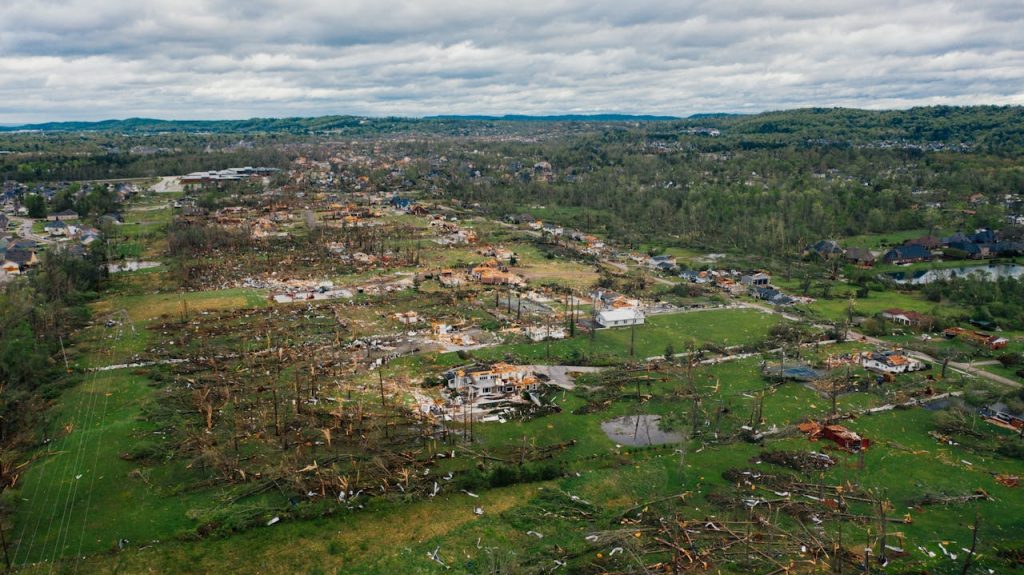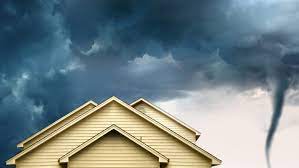Tornadoes rank among the most devastating natural disasters, capable of forming rapidly with minimal warning and inflicting widespread destruction in mere moments. Unlike hurricanes, which often provide days of lead time.
Tornadoes can develop and touch down within minutes—leaving little opportunity to react. For this reason, proactive preparation is not just recommended; it is essential. Taking steps to ready your home before tornado season begins can significantly reduce the risk of structural damage and injury.
It also ensures that you and your loved ones have access to vital supplies and shelter when seconds count. By preparing in advance, you place yourself in a far stronger position to face these unpredictable and violent storms with greater resilience and safety.
Read More: How to Get Your House Ready for Tornado Season
Designate a Safe Shelter Within Your Home
A critical component of tornado preparedness is identifying a secure location in your home where you and your family can take shelter during a storm. The ideal option is a purpose-built storm shelter or a basement, as these areas offer the highest level of structural protection from high winds and flying debris.
If a basement is not available, select a small, windowless interior room on the lowest floor—such as a bathroom, closet, or central hallway. Spaces beneath staircases can also provide adequate shelter. Steer clear of windows, exterior walls, and doors, which are highly vulnerable to breakage and debris intrusion.
For enhanced safety, fortify your chosen area with sturdy furniture, mattresses, or thick blankets to help shield against potential impact.
Secure Windows, Doors, and Roof
Tornadoes generate intense winds capable of shattering windows, forcing doors open, and ripping roofs from homes. Strengthening these critical areas can significantly reduce the risk of structural damage and enhance your home’s resilience during a storm.
Start by installing storm shutters or upgrading to impact-resistant windows to protect against flying debris. If those options are unavailable, covering windows with securely fastened plywood before a storm offers a reliable alternative.
Doors should be equipped with heavy-duty hinges and reinforced with strong deadbolts to prevent them from being blown open. Garage doors, a common weak point, can be stabilized with bracing kits or hurricane straps. To protect your roof, use metal fasteners or hurricane clips.
When replacing or constructing a roof, consider durable, impact-resistant materials to maximize long-term safety.
Secure Outdoor Items and Vehicles
In high-wind events such as tornadoes, unsecured outdoor items can turn into hazardous projectiles, posing serious threats to your home, vehicles, and neighboring properties. Proactive measures to secure or relocate outdoor belongings can significantly reduce the risk of injury and damage.
Bring lightweight or loose items indoors, including patio furniture, grills, potted plants, and trash bins. Anchor larger structures such as sheds, playsets, and fences using ground stakes, anchors, or heavy-duty fasteners to ensure they remain stable during extreme weather.
Whenever possible, park vehicles inside a garage. If no garage is available, choose a location away from large trees, fences, and power lines. In areas susceptible to both tornadoes and flooding, additional precautions like placing sandbags around vulnerable entry points can help protect against water intrusion.
Trim Trees and Remove Hazardous Branches
Overgrown or weakened trees pose a significant threat during tornadoes, as high winds can snap branches or uproot entire trees, leading to severe damage to homes, vehicles, and power lines. Regular tree maintenance is an essential part of tornado preparedness and can greatly reduce the risk of injury and property loss.

Prune dead, damaged, or overhanging branches that could become airborne during a storm. Remove unstable or leaning trees located near your home, especially those with shallow root systems. When planting new trees, choose wind-resistant species such as oak or hickory, and position them at a safe distance from structures.
By addressing these hazards well before tornado season, you enhance the safety of your property and help protect windows, roofs, and siding from flying debris.
Assemble a Comprehensive Emergency Supply Kit
A well-prepared emergency supply kit is essential for ensuring safety and self-sufficiency during and after a tornado. Store your kit in your designated safe room, and ensure every household member knows its location and contents.
Your emergency kit should include enough essentials to support each person for at least 72 hours. Key items include:
- Non-perishable food and bottled water
- Flashlights with extra batteries
- A fully stocked first-aid kit
- A NOAA weather radio or battery-powered radio for real-time alerts
- Important documents—such as insurance, identification, and medical records—secured in a waterproof container
- Prescription medications and basic hygiene products
- Sturdy footwear and extra clothing
Establish a Family Communication and Evacuation Plan
In the chaos of a tornado, clear communication and swift action are critical. Developing a comprehensive family emergency plan ensures that every member of your household knows exactly what to do and where to go when severe weather strikes.
Designate a safe indoor meeting location—preferably your home’s storm shelter or interior safe room—and identify a secondary outdoor meeting point in case you are separated. Compile a list of emergency contact numbers and place copies in your emergency kit and with each family member.
Teach children how and when to call 911 or local emergency services.Conduct regular tornado drills to reinforce quick, calm responses during an actual event. Additionally, familiarize yourself with your community’s tornado warning system so you can respond without delay when alerts are issued.
Learn How to Safely Shut Off Utilities
Tornadoes can cause significant damage to essential utility systems, including power lines, gas pipes, and water supplies. Knowing how to quickly shut off these utilities can help prevent dangerous situations such as gas leaks, electrical fires, and flooding after a storm.
Gas: If you smell gas or suspect a leak, immediately turn off the main gas valve to prevent potential explosions or fires.
Electricity: In the event of flooding or structural damage, switch off the main electrical breaker to reduce the risk of electrical fires or shock.
Water: Close the main water valve to stop potential flooding or contamination of your water supply.
Review Your Insurance Policy
Tornadoes can cause significant financial loss, making it essential to review your homeowner’s insurance policy before storm season. Ensure your coverage includes the following:
- Protection for wind and storm damage
- Additional flood insurance if your area is vulnerable to heavy rainfall
- Up-to-date inventory records and photographs of your home and belongings for proper documentation
Store all important documents in a secure, waterproof container to facilitate a smooth claims process in the event of damage. By proactively reviewing and updating your policy, you can ensure that you are adequately protected should disaster strike.
Stay Informed and Take Immediate Action
Staying informed about tornado warnings and alerts is crucial for your safety. Ensure you have multiple reliable sources to receive real-time updates, such as:
- NOAA Weather Radio for continuous alerts
- Smartphone apps and weather notification services
- Local news and emergency broadcasts
Understand the difference between the following alerts:
Tornado Watch: Conditions are favorable for a tornado to develop—remain alert and prepared
Tornado Warning: A tornado has been sighted—take immediate action and seek shelter
If a tornado warning is issued:
- Immediately move to your designated safe shelter
- Protect your head and body from flying debris
- Remain indoors until you receive an all-clear signal from authorities
Frequently Asked Questions (FAQs)
What is the difference between a tornado watch and a tornado warning?
Tornado Watch: Conditions are favorable for a tornado to form. Stay alert and be prepared to take action.
Tornado Warning: A tornado has been detected or spotted. Seek shelter immediately and follow safety procedures.
Where is the safest place to take shelter during a tornado?
The safest place is in a storm shelter, basement, or an interior room on the lowest floor, away from windows and exterior walls. If a basement or storm shelter isn’t available, consider a small, windowless room such as a bathroom, closet, or hallway.
How can I secure my home to prevent tornado damage?
Strengthen windows, doors, and the roof with storm shutters, impact-resistant windows, and hurricane clips or metal fasteners. Also, trim trees and secure outdoor items that can become dangerous projectiles.
What should I include in my emergency kit?
Your kit should include at least three days’ worth of non-perishable food, bottled water, a first-aid kit, flashlight, extra batteries, a NOAA weather radio, important documents in a waterproof container, and medications. Don’t forget supplies for pets if you have them.
What should I do if I smell gas after a tornado?
If you smell gas, immediately turn off the main gas valve to prevent the risk of fire or explosion. Avoid using electrical switches or creating sparks, and leave the house if necessary.
How can I prepare my family for a tornado?
Develop a family communication and evacuation plan. Choose a designated safe meeting place, share emergency contact information, teach children how to call emergency services, and practice tornado drills regularly.
Conclusion
Preparing for a tornado is essential to ensuring the safety of your home and loved ones. By taking proactive steps—such as securing your shelter, reinforcing your home’s structure, maintaining an emergency kit, and staying informed—you can significantly reduce the risks posed by these powerful storms.

